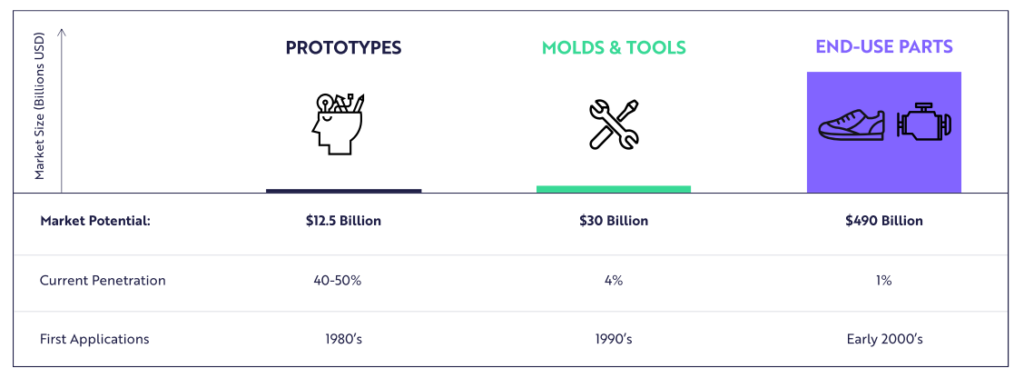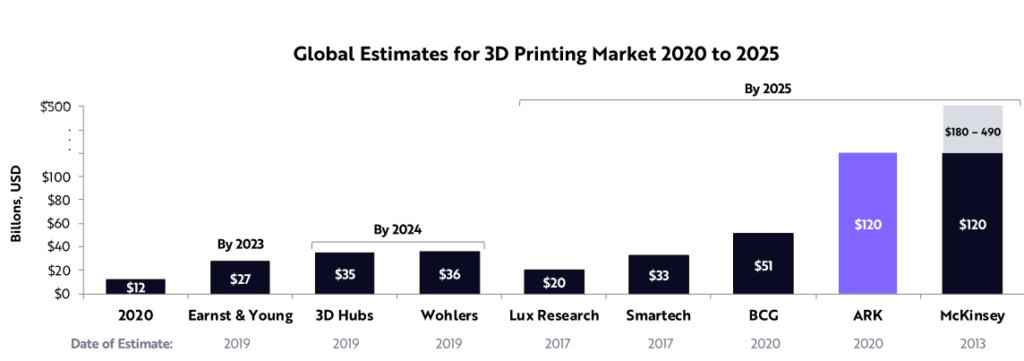3D printing offers a glimpse into the future, where manufacturing and transport networks could be completely overhauled through on-demand, mobile and flexible production channels.
Whilst the industry has been in existence for decades, recent reductions in the cost of materials and 3D printers have made the prospect of mainstream usage increasingly more likely.
The value proposition of 3D printing in a business-to-consumer (B2C) context is simple – imagine you are cooking at home, and the handle on your reliable, but well-used knife breaks as you begin to dice vegetables.
You don’t have any other appropriate knives to cut your vegetables with, and you don’t want to go to the shops because it is raining, or – more relevant to current times – because the area you live in is going through an outbreak of COVID -19.
Instead, you go online and buy the design of a knife from Amazon and upload those designs into your 3D printer through your computer.
Within a short period of time, the 3D printer is able to create the knife, either out of plastic or metal, and you are able to continue on cooking.
Such processes already exist within rapid prototyping, which has enabled companies to create prototypes for products within a matter of hours, instead of going through the laborious process of sending designs back and forth to manufacturers until you arrive at the perfect design.
In a business-to-business (B2B) context, 3D printing could replace current manufacturing networks through enabling production facilities to continually change what goods they produce without having to change any underlying processes – only the designs uploaded into the 3D printers.
If everyone were to have access to similar 3D printers, barriers to production would be significantly reduced, where transport would become the most important cost, leading towards selecting producers on the basis of geographical proximity.
People have long said that money can’t buy you happiness, but in the near future it will be able to buy you a 3D printer which can make almost anything (potentially even another human).
In today’s note, we will cover 3D printing – how it works, why it has failed to live up to expectations in the past, and the ways in which investors can gain exposure.
How Does 3D Printing Work?
3D printing is commonly referred to as additive manufacturing, which is reflective of its differences with standard manufacturing processes.
In standard manufacturing processes, you usually start with a base material, and use moulding or subtractive methods to create your desired end product.
3D printing has no base material, instead building from the bottom up.
3D printing can be undertaken in multiple forms – the most common of which being fused depositional modelling (FDM).
This method is what most people would associate with 3D printing, where a 3D model is built up one layer at time, with mechanics very similar to that of an inkjet printer.
Instead of using ink, FDM printers use plastic polymers (which can be mixed with wood, ceramics, metal and carbon fibre) through a heated nozzle, effectively creating a series of 2D prints which sit on top of each other fused together through the melting of plastic.
3D printing can also be conducted through Stereolithography Apparatus (SLA), which involves the use of plastic polymers, but also a binding agent in between each layer (with this binding layer taking the form of a curable photopolymer hardened by UV light). It is a faster, more reliable and more precise, however it carries greater cost.
FDM Printing

Source: Diagram Database
Similar methods can be used in direct metal laser sintering (DMLS) and laser metal deposition (LMD) which use metal instead of plastic.
3D Printing For A 3D World?
3D printing has long been touted as the technology of the future, however year after year, market estimates have continued to fall short.
But why has the 3D printing industry continued to disappoint those who have tried to expose themselves to the purported technology of the future?
Currently, 90% of 3D printing is used for rapid prototyping and tooling (Rayna 2021), with direct manufacturing and consumer production still yet to take flight.
The bull case for 3D printing lies in these two relatively untapped markets, which have yet to be penetrated due to a multitude of reasons.
3D printers are currently quite costly, and sensitive to their environments, with potential vectors of failure coming from humidity, vibrations, temperature, and quality of materials.
The processes required to design and upload objects to be 3D printed – even if they are as simple as a mug, is beyond the technological grasp of most consumers.
As a result, 3D printing has been operating only in niche markets, such as customisable prosthetics (perfectly fitted to the recipient’s body), aerospace parts, and customisable shoes.
Thus, as things stand, 3D printing requires considerable improvements in user friendliness to achieve the growth prospects which have been attached to the industry for years.

Source: Ark Invest
In order for 3D printing to be adopted in the mainstream, improvements would have to be made through integration of other emerging technologies, like artificial intelligence (which we touched on recently) and augmented reality.
Artificial intelligence would substantially improve the feasibility of 3D printing on a widespread scale, through increasing efficiency of production and enhancing quality through collecting data on similar projects, both locally and globally.
How To Gain Exposure to 3D Printing
3D Systems (NYSE: DDD)
3D Systems is a market leader in additive manufacturing, primarily specialising in high end digital dentistry, metal implants/instrumentation for orthopaedic, spinal, and veterinary applications, as well as the provision of parts in aerospace, defence and jewellery industries.
As of the writing of this note, 3D Systems is up 31% for the week due to the announcement of their partnership with Collplant to 3D print a soft tissue matrix on which the human body can grow new skin. This will be used to support reconstructive surgery for those patients undergoing mastectomies, however potential use cases expand far beyond this as medical procedures continue to develop.
The key driver behind the price movement was the material which will be used in the 3D printing, which is a plant based recombinant human collagen (rhCollagen), proven to be safe, reliable, consistent, and of a high quality.
This news is important as rhCollagen could be used in other reconstructive and plastic surgeries, where the industry could be on the verge of a breakthrough in terms of being able to build human body parts through 3D printing.
If 3D Systems is able to continue to expand its ability to create human organs through 3D printing, the industry could be set to experience the growth which has been predicted for years.

Source: Bloomberg
The 3D Printing ETF (BATS: PRNT)
PRNT is designed to track the entire 3D printing industry, indexed to the Total 3D-Printing Index. It offers a diversified exposure to the industry, with companies ranging from the aforementioned 3D Systems to large cap companies like Microsoft.

Source: Ark Invest
It’s position as an index fund, unlike Ark’s other thematic ETF’s, should mean that it would be subject to less volatility, given weightings are based primarily on market capitalisation, as opposed to manager selection, creating a reduced likelihood in significant positions within illiquid shares.
3 Cheers for 3D Printing
Investors may have lost enthusiasm for 3D printing given its past failings, however new developments in the production of human tissues and organs will continue to drive positive share price performance in the short term.
Whether or not these price movements can be sustained is another question, with the success of AI based integration and cost bases serving as the key drivers for long term performance.
Given 3D printing shares trade on lofty multiples, investors must be cautious and aware of the volatility which they will be subject to – strong portfolio returns do not grow on trees, nor can they be created in a 3D printer.
The views expressed in this article are the views of the stated author as at the date published and are subject to change based on markets and other conditions. Past performance is not a reliable indicator of future performance. Mason Stevens is only providing general advice in providing this information. You should consider this information, along with all your other investments and strategies when assessing the appropriateness of the information to your individual circumstances. Mason Stevens and its associates and their respective directors and other staff each declare that they may hold interests in securities and/or earn fees or other benefits from transactions arising as a result of information contained in this article.



